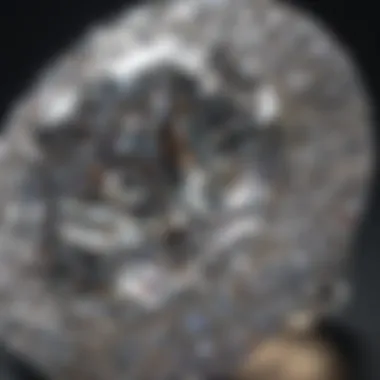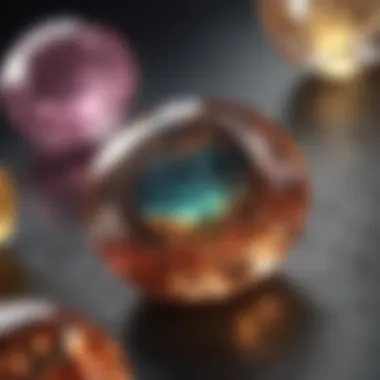Understanding Clarity in Gemstones: A Comprehensive Guide


Intro
Clarity in gemstones is not just a term tossed around in gemological circles; it stands as a cornerstone of both beauty and value in the gemstone world. At its core, clarity refers to the absence of inclusions and blemishes within the stone, which dramatically impacts how light interacts with the gem, thereby affecting its brilliance and overall aesthetic appeal. For collectors, enthusiasts, and designers alike, clarity serves as a guiding principle for evaluating stones, one that carries considerable weight in determining market price and desirability.
From diamonds to sapphires, understanding clarity can open doors to deeper appreciation and informed decision-making. With clarity playing such a pivotal role, this guide seeks to elucidate the complexities surrounding this intriguing facet of gemstones, ensuring readers emerge with the insights necessary to navigate the sparkling landscape of gem collecting.
Gemstone Overview
Description of the gemstone
Gemstones manifest in diverse hues, shapes, and structures, each showcasing unique characteristics shaped by geological processes. They are often classified into two distinct categories: precious and semi-precious stones. Precious stones, such as diamonds, rubies, sapphires, and emeralds, are the crème de la crème, prized for their rarity and exceptional beauty. On the other hand, semi-precious gemstones include amethyst, garnet, and aquamarine, still captivating but generally more abundant.
Each gemstone carries its own tale, marked by the conditions of its formation deep within the Earth, whether it's through metamorphic, igneous, or sedimentary processes. These stories are often reflected in their physical properties, including color, hardness, and clarity.
Physical properties
The physical properties of gemstones are a crucial consideration for any connoisseur. Here are some key characteristics to keep in mind:
- Hardness: Measured on the Mohs scale, hardness indicates a stone's resistance to scratches. Diamonds sit at the top as the hardest known material, while talc represents the softest.
- Specific Gravity: This is a measure of how dense the gemstone is compared to water. Knowing the specific gravity can help in identifying a gem’s authenticity.
- Optical Properties: Refers to how light interacts with the stone. This includes refraction, which can create an alluring effect of brilliance, known as fire in diamonds and other transparent gems.
Each of these properties can provide clues not only to the gemstone's origins but also to its overall quality. Evaluating these aspects will help enthusiasts to differentiate between run-of-the-mill stones and those truly worth collecting.
"Understanding physical properties is essential for anyone serious about gemstone appreciation. It’s not just about visual appeal; it's about knowing the science that enhances that beauty."
Healing Properties
While clarity often garners the spotlight, many believe that gemstones also channel unique metaphysical properties, enriching the experience of those who wear or use them. This belief extends to various cultures and practices around the world.
Metaphysical attributes
Many gemstones are endowed with healing attributes. For example, amethyst is lauded for its calming properties, thought to relieve stress and promote restful sleep. On the other hand, citrine is often associated with prosperity and positivity—said to attract abundance and boost creativity. These metaphysical claims might not be backed by scientific evidence, but they do add another layer of value for many collectors. The emotional resonance of a stone can be just as significant as its physical characteristics.
Common uses in holistic practices
Gemstones play a prominent role in holistic healing practices. Here are some common applications:
- Crystal Healing: Many practitioners use gemstones as tools for energy work, placing them on specific parts of the body to aid in emotional and physical healing.
- Meditation and Focus: Some stones, like quartz, are commonly used in meditation, helping individuals to center their thoughts and connect with their inner selves.
- Feng Shui: Certain gemstones are believed to enhance the flow of energy within spaces. For instance, rose quartz is often used to foster unconditional love and harmony in a home.
Understanding these dimensions provides a broader perspective on the significance of clarity and quality in gemstones, especially for those integrating stones into their personal and spiritual practices. As we venture deeper into evaluating clarity in various stones, keep these aspects in mind. They will not only enrich your appreciation but also guide you in selecting stones that resonate on multiple levels.
Defining Clarity in Gemstones
Defining clarity in gemstones is not just a matter of assessing the physical state of a stone. It delves into the art and science of understanding a gem's inherent beauty, flaws, and overall character. For gemstone enthusiasts, collectors, and jewelry designers alike, clarity serves as a key indicator of quality, which can impact aesthetic appeal and market value. In this section, we will shine a light on what clarity truly means and unravel the roots of the terminology often associated with this concept.
What is Clarity?
Clarity, in simple terms, refers to the transparency and purity of a gemstone. It addresses how free a stone is from inclusions, blemishes, or any other internal or external imperfections. In gemstones, a crystal's clarity is often evaluated on a spectrum; the clearer the stone, the more valuable it typically is.
When professionals assess a gem's clarity, they utilize a scale ranging from "Flawless" to "Included," categorizing stones based on visibility of inclusions under magnification. For instance, a flawless diamond shows no inclusions that can be seen even under a ten-power magnifying lens. On the contrary, a stone graded as included will have noticeable flaws that affect its overall appearance. Understanding these designations can aid collectors in making informed decisions when purchasing.
It's essential to recognize that clarity levels can also influence a gemstone's color saturation and brilliance. A well-cut stone with high clarity will maximize light performance, enhancing its visual appeal—just as striking as the stone's original hue.
The Origins of Clarity Terminology
The terminology surrounding clarity has a significant history, intimately tied to the evolution of gemology itself. The first documented classifications stem from the mid-19th century, brought about by increasing interest in gemstones among collectors and jewelers. Initially, the criteria to evaluate clarity varied widely, often subjective and based on individual opinions.
The formalization of clarity terms came to fruition as experts realized the need for a standardized language to allow for consistent evaluations. Organizations like the Gemological Institute of America (GIA) played a pivotal role in defining clarity grades in the 1930s.
These classifications, which still hold today, have been built up through decades of careful observation and research, providing a clear guideline for recognizing the beauty or flaws within gemstones. This structured approach not only preserves the integrity of gem evaluations but also educates buyers on the subtle nuances of clarity, equipping them to appreciate the finer details inherent within each stone.


"Clarity is a window into the gemstone's soul, revealing tales of its formation and journeys beneath the earth's surface."
The journey of understanding clarity is vital for anyone passionate about gemstones. Appreciating the nuances in clarity can elevate the appreciation for these beautiful creations of nature, making every piece chosen not only a purchase but a connection to the earth's story.
The Importance of Clarity
Clarity stands at the forefront when it comes to appreciating gemstones. This quality doesn't just play a role in the gemstone's beauty but significantly impacts its value. When examining the intricacies of clarity, it's essential to recognize that each stone tells a story, and clarity is a crucial chapter in that narrative. Understanding this aspect allows gem enthusiasts to make informed choices, enhancing not only their collections but also their overall appreciation of these natural wonders.
Influence on Beauty and Aesthetics
The relationship between clarity and aesthetics is profound. A gemstone with high clarity presents a clean and vivid appearance, allowing light to dance within it and create that coveted sparkle. Take a diamond, for example. Often, the brilliance is impacted by just how clear the stone is. The fewer inclusions – those little internal flaws or blemishes – present, the more vibrant the glimmer. When selecting a sapphire, many collectors might say that the more transparent the stone, the richer the color appears. Clarity enhances the depth and intensity of hues, playing a pivotal role in the gemstone's overall aesthetic appeal.
In contrast, inclusions can affect how eye-catching a stone is. Some individuals even find a certain charm in inclusions, appreciating the unique characteristics they bring. This is where personal preference comes into play. Still, clarity is one of those factors that cannot be overlooked, as it lays the foundation for that visual feast.
"Clarity breathes life into gemstones, letting their true colors shine through."
Impact on Value and Pricing
Clarity significantly influences the market value of a gemstone. In the world of gemstones, the old adage holds true: beauty is in the eye of the beholder, but clarity often dictates price. For instance, diamonds are typically graded on a clarity scale with varying levels, from flawless to included. A flawless diamond fetches a higher price not just due to its clarity but also because it represents the pinnacle of perfection sought after in the market.
The same is true for other gems like emeralds and rubies. An emerald with high clarity is considerably rarer; therefore, it commands a higher price. On the flip side, a ruby that has noticeable inclusions can result in a significant drop in its market value. This means that potential buyers and collectors should weigh clarity not just as a feature but as a critical factor in their investment decision.
In summary, clarity is not merely a feature of gemstones; it is an integral aspect that influences both beauty and worth. Whether you are a casual admirer or a seasoned collector, considering this element can guide you towards making choices that truly resonate with your personal taste and investment concerns.
Types of Clarity in Gemstones
When one embarks on the journey into the world of gemstones, understanding clarity is paramount. Clarity is not a mere buzzword; it’s the essence that links a stone's aesthetic appeal to its value. Each type of clarity offers unique insights into a gemstone's formation, authenticity, and overall market value. So, diving deeper into the various types of clarity helps enthusiasts not only appreciate the beauty of their jewels but also make informed decisions during their selection process.
With clarity grading systems in place, one can distinguish between high-quality stones and those that may not meet expectations. Moreover, identifying clarity types sheds light on the actual story behind each gemstone, turning a simple piece of jewelry into a narrative of nature’s artistry and the geological processes at play.
Different Clarity Grades
Clarity grades range from flawless to included, painting a broad spectrum of quality for gemstones. Here’s a simplified overview of the most recognized clarity grades:
- Flawless (FL): These gems show no inclusions or surface blemishes visible under 10x magnification. A rare find indeed!
- Internally Flawless (IF): While there are no inclusions visible under magnification, some minor surface blemishes may appear.
- Very Very Slightly Included (VVS1 & VVS2): These stones have slight inclusions that are difficult to see, even to a trained eye.
- Very Slightly Included (VS1 & VS2): Slight inclusions are noticeable under 10x magnification, but they still won’t significantly detract from value.
- Slightly Included (SI1 & SI2): Inclusions are visible under magnification, and may or may not be visible to the naked eye.
- Included (I1, I2 & I3): These gemstones contain noticeable inclusions that may affect transparency and brilliance.
Each grade presents a unique take on how inclusions influence the allure of the stone. Some collectors even argue that inclusions can add character to certain gemstones, making them more intriguing.
Examples of Clarity Levels in Popular Gemstones
Popular gemstones each exhibit their own clarity traits, providing a fertile ground for discerning collectors:
- Diamonds: Often deemed the benchmark for clarity, diamonds are rated based on their cuts, with flawless stones fetching astronomic prices. A beautiful diamond can even sport a small inclusion that tells its story—perhaps a sign of its long, geologic history.
- Sapphires: These stones might have silk inclusions, which, while decreasing clarity, enhance their color and luster. The infamous "star sapphires" showcase such inclusions in a remarkable way, creating a star-like phenomenon in the stone when light hits it just right.
- Emeralds: Unique for their characteristic inclusions known as "jardin," these natural features evoke a sense of organic beauty. Many collectors cherish the unique flaws in emeralds, as they demonstrate authenticity.
- Rubies: Similar to sapphires, rubies can feature inclusions, which can also enhance their allure based on how they reflect light. In some cases, rubies with slight inclusions may be more desirable due to their unique character.
In the lush world of gemstones, understanding clarity creates a roadmap for exploration. It helps enthusiasts appreciate each unique gem, going beyond mere visual appeal. Getting familiar with clarity types enhances one’s ability to evaluate stones correctly, enabling educated purchasing decisions.
"Clarity isn’t just a grade - it’s a perspective, a story etched in stone."
Whether you’re a long-time collector or a budding enthusiast, thus arming yourself with knowledge about types of clarity in gemstones will ultimately enrich your experience, leading you to gems that truly resonate with you.
Evaluating Clarity
Evaluating clarity serves as a pivotal step in understanding gemstones, informing both collectors and purveyors about the quality of their prized finds. The clarity of a stone speaks to its purity — the lesser the flaws, the higher its perceived quality. When buyers consider their options, they often ponder how these imperfections affect the visual allure, emotional connection, and ultimately, the valuation of the gemstone they are admiring. In an age where consumers are ever more discerning, grasping clarity means more than just aesthetics; it influences the stone’s market demand and longevity in an ever-shifting landscape.
The significance of evaluating clarity extends into various realms. For one, it impacts appreciation. Enthusiasts aiming to invest in gemstones must familiarize themselves with grading to understand beauty nuances better. Just as a pianist grades notes to compose symphonies, so too must a gem lover know each stone’s lyrical intricacies. Furthermore, knowing clarity forms a bedrock for informed purchasing decisions. This knowledge shields buyers from scams and overpricing, while also fostering a deeper appreciation for a gem’s origin and craftsmanship.
Tools and Techniques for Assessment
Using the right tools is essential for evaluating clarity accurately. There are many devices available that can enhance the assessment process and provide clarity levels with precision.


- Loupe or Magnifying Glass: A simple yet indispensable tool, a loupe magnifies gemstones, allowing for a close inspection of their internal features. A professional loupe offers 10x magnification, which reveals inclusions that might not be visible to the naked eye.
- Lightbox: Illuminating the stone from behind, a lightbox helps showcase the inclusions or any visible color zoning. Gemstones can appear very different when facet brightness is at play, hence this tool can give real insight.
- Microscope: For the aficionado who values detail, a microscope can dissect the nuances of a stone at higher magnifications. This is crucial for identifying specific types of inclusions, whether it's a feather, needle, or crystal formation.
- Digital Imaging: High-resolution captures can provide detailed images that can be further analyzed for clarity assessment. These images can be useful for record-keeping or sharing with fellow enthusiasts.
Understanding clarity through the use of these tools can turn a leisurely hobby into a well-informed passion, laying groundwork for deeper exploration and more thoughtful collection.
Interpreting Clarity Ratings
Once clarity has been assessed, the next step involves interpreting those ratings. Clarity grades typically range from Flawless to Included, often denoted on a scale that gives potential buyers an insight into what they might expect.
- Flawless (IF): No inclusions, visible even under 10x magnification. These stones represent the pinnacle of clarity.
- Very Very Slightly Included (VVS1 & VVS2): Very small inclusions that require careful observation to detect; they are considered excellent quality for most buyers.
- Very Slightly Included (VS1 & VS2): Some inclusions are visible under 10x magnification but are minor and do not significantly affect beauty.
- Slightly Included (SI1 & SI2): Inclusions are easily visible under magnification and may or may not affect the stone’s overall beauty.
- Included (I1, I2, I3): Inclusions are visible to the naked eye; these stones typically reflect more moderate practices in evaluation and convey a lower price point.
When interpreting these ratings, consumers should consider not only the clarity grade but how it aligns with their expectations and aesthetic preferences. A lower clarity rating might still yield a visually appealing stone, especially for designs that embrace unique character over pristine condition. This understanding ultimately allows enthusiasts to appreciate gemstones on a deeper level and helps in curating collections with intention.
"Depth and complexity can mean different things in various contexts, even in clarity assessment, where a stone's story can often add more value than its flawless exterior."
By adopting these principles, gemstone collectors can navigate the world of clarity assessments, forging paths that resonate with personal appreciation and informed investment.
Common Misconceptions about Clarity
Understanding the misconceptions surrounding clarity in gemstones is essential for both enthusiasts and collectors. These misunderstandings can obscure a gemstone's true beauty and misguide decisions in purchasing and appraising stones. By unpacking the myths around clarity, we can cultivate a deeper appreciation for these natural wonders. Let's explore the tangible benefits of distinguishing fact from fiction in this domain, as not all that glitters is clear.
Myths vs. Reality in Clarity Assessment
One prevalent myth is the notion that higher clarity always means a more valuable gemstone. This perspective is oversimplified. Yes, clarity does play a key role, but it's not the only factor that dictates a gemstone's worth. For instance, a vibrant colored gemstone with noticeable inclusions might fetch a higher price than a visibly clear but dull stone. In this way, color intensity and saturation often out-weight clarity grades.
Another common notion is that diamonds are the only stones where clarity matters significantly. This is misleading. While diamonds are often evaluated primarily on clarity, other gemstones also have their own grading criteria. Sapphires, emeralds, and rubies, for example, have various inclusions or "blemishes" that can enhance their charm, often showcasing their journey through time more than their perceived defects.
Thus, it's crucial to approach clarity with a balanced viewpoint, recognizing that context matters. This clarity assessment varies across different types of gemstones.
"Quality gemstones often flaunt their inclusions; it tells a story that pure stones may not convey."
The Role of Inclusions in Gemstone Appreciation
Inclusions, those often-missed specks or feather-like structures within a gemstone, play a fascinating role in how we perceive and appreciate these stones. Many may view inclusions as flaws, a detrimental mark against clarity, but this view is not only limited, it's largely misguided.
In fact, inclusions are rather like fingerprints; they can make each stone unique and provide insight into its origin. For example, some gemstones are celebrated specifically for their inclusions. The infamous "silk" in some sapphires can enhance their appearance, casting a soft glow that contributes to their allure. Similarly, the feathers in diamonds can, contrary to intuition, become less noticeable when the gem is set in jewelry, allowing for deeper depths of sparkle.
Moreover, inclusions are critical for gemologists when classifying and verifying a stone's authenticity. Identifying specific inclusions can help determine the origin of the gemstone, thus allowing collectors to verify provenance effectively. Hence, understanding the role of inclusions nudges collectors to look beyond traditional clarity metrics and appreciate each stone’s individual character.
In summation, these misconceptions about clarity can lead to misunderstandings, hindering true appreciation for the complexity and beauty of gemstones. Educating oneself on these aspects opens up new avenues for value and beauty appreciation, making clarity not merely a technical aspect but an undeniable part of the gemstone's identity.
Clarity and Gemstone Treatments
When we talk about clarity in gemstones, it's not just about the inherent properties of the stone itself. It's also vital to recognize how various treatments can influence a gemstone’s clarity. Treatments are often utilized to enhance the appearance and value of stones, but they can also complicate the narrative around a gem’s authenticity and quality. Understanding this relationship is essential for any gem enthusiast, as it informs both appreciation and purchasing decisions.
Types of Treatments Affecting Clarity
There are several treatments that gemstones may undergo, each with its own impact on clarity:
- Heat Treatment: This is one of the most common methods, especially for stones like sapphires and rubies. Heating can help to eliminate impurities and enhance color, but it can also change the appearance of inclusions, affecting the overall clarity.
- Oil Treatment: Often used for emeralds, oiling fills surface-reaching fractures, which can noticeably improve clarity. However, it's crucial to distinguish between an oiled gemstone and one that is naturally clear.
- Fracture Filling: This technique often involves injecting resin into cracks to make them less visible. This can dramatically change the clarity perception, but it raises questions about the longevity of the stone’s clarity and can affect its long-term value.
- Radiation Treatment: This treatment can alter a gem’s color, particularly in natural stones. While it might enhance visual appeal, the clarity might not improve, and the treatment can lead to ethical concerns.
- Coating: Some gemstones are coated to enhance or alter their color. This treatment can mask clarity issues, leading to potential misconceptions about the true quality of the stone beneath.
Different treatments have varying effects on a gemstone’s clarity and, by extension, on its desirability. Awareness of these treatments can equip potential buyers to make informed choices, ensuring they are not duped by sparkling facades.
Ethics and Transparency in Treatment Disclosure
With the rise of treatments, the ethical considerations related to gemstone clarity are ramping up like never before. Transparency is paramount. Gemstone treatments should be disclosed clearly at the time of sale, and buyers should expect this level of honesty.
- Understanding Treatment Disclosure: Suppliers and jewelers are ethically expected to provide information regarding any treatments performed. This honesty plays a massive role in establishing trust in the buying process. After all, if a buyer thinks they’re purchasing an unaltered, naturally clear stone, only to find out it has undergone treatments, it can lead to feelings of betrayal.
- Valuation Implications: Treatments can drastically change the market value. A natural, untreated stone often possesses a significantly higher value than a treated one, even if both rocks appear similar to the naked eye. Therefore, knowing whether a stone was treated or not is intrinsic to understanding its true worth.
- Emerging Standards: Organizations like the Gemological Institute of America have implemented strict guidelines surrounding the disclosure of treatments. While these standards are not universally adopted, they represent an important movement towards accountability.
Caring for Gemstones and Maintaining Clarity


Caring for gemstones is an often overlooked aspect of gemstone ownership, yet it plays a monumental role in preserving their beauty and symmetry. Clarity is not merely a quality assessed during the buying process; it is an ongoing concern that directly influences the longevity and allure of a gem. Keeping gemstones clear and sparkling requires thoughtful consideration, proper technique, and a bit of regular maintenance. The benefits are crystal clear—by ensuring clarity through proper care, collectors and enthusiasts boost the value and aesthetic appeal of their precious stones.
Having a gemstone is akin to owning a piece of art. Just as paintings require cleaning and protection from sunlight, gemstones need careful handling and upkeep to prevent scratches, cloudiness, and other forms of damage. To maintain the clarity of your stones, it is essential to consider factors such as environmental exposure, storage conditions, and cleaning methods. Let’s dive into these components in more detail.
Best Practices for Preservation
- Regular Cleaning: Dust and dirt accumulation can dull any gem's brilliance. It’s prudent to clean gemstones regularly using a soft cloth and mild soap with lukewarm water. Rinse and dry thoroughly to remove residues. Avoid using harsh chemicals or ultrasonic cleaners, as they can adversely affect certain stones.
- Storage Matters: Where you keep your gemstones can be just as crucial as how you clean them. Store each piece separately in a soft pouch or a padded jewelry box to avoid scratches. Keep them away from direct sunlight, as prolonged exposure may fade colors or damage certain types of stones.
"A little bit of maintenance today keeps the jeweler away tomorrow!"
- Wear With Care: Always be mindful of when and how you wear your jewelry. Avoid wearing gemstones while engaging in vigorous activities, such as sports or cleaning, where they may experience impact or scratches. Consider putting on your rings or bracelets after applying lotions or perfumes.
- Seek Professional Help: For gemstones that hold significant value or require intricate care, don't hesitate to consult a professional jeweler. They have tools and techniques in their toolkit to ensure your gems receive the thorough attention they require.
Understanding Damage and Wear
Over time, even the most well-cared-for gemstones can succumb to various forms of damage. Being aware of what can harm your stones is vital in mitigating future issues.
- Common Types of Damage: Scratches are the most prevalent issue for gemstones, particularly those with lower Mohs hardness. Other potential damages include chips or fractures caused by hard impacts. It’s essential to inspect your stones regularly for any visible wear, as early detection can prevent more significant issues down the road.
- Inclusions Impact: Some gemstones naturally have inclusions, small imperfections within the stone. While some may find beauty in these natural characteristics, they can also make gems more susceptible to damage. Be particularly cautious with stones that are known to have such traits, as these can alter their clarity over time.
- Chemical Reactions: Be mindful of the products that come in contact with your jewelry. Certain substances can cause gemstones to react negatively, leading to lasting damage. For instance, chlorine can dull the luster of pearls and affect the integrity of some other soft stones.
By adopting best practices for preservation and understanding potential damage, gemstone enthusiasts can keep their treasures sparkling and inviting. Maintaining clarity isn’t just a chore; it’s a foundation for enjoying and valuing these natural wonders.
Future Trends in Clarity Assessment
As we step further into a technology-driven era, the landscape of gemstone clarity assessment is evolving rapidly. Understanding these future trends is essential for enthusiasts and collectors alike, as they could influence how gemstones are evaluated, valued, and appreciated.
Technological Advances in Clarity Analysis
The emergence of cutting-edge technology is reshaping the way clarity in gemstones is assessed. Tools that once relied heavily on the trained eye and experience of a gemologist are now being supplemented, or even replaced, by advanced methods utilizing sophisticated imaging and analysis.
- 3D Imaging: High-resolution 3D imaging allows for a detailed look at the internal structure of gemstones. This technology can uncover tiny inclusions or fractures that the naked eye might miss. It also helps in creating a more three-dimensional representation of the gem, making it easier to visualize.
- Spectroscopy: This advanced technique analyzes how gemstones interact with various wavelengths of light. By studying the spectrum produced, experts can gain insights into the stone’s clarity while also examining its chemical composition.
- Artificial Intelligence: Machine learning algorithms are being deployed to evaluate gemstone clarity with remarkable precision. These systems can analyze large datasets, compare clarity grades, and even predict how certain treatments may impact the clarity over time.
These technological strides are not only enhancing clarity analysis but also bringing about significant standardization in the evaluation process. With tools becoming more accessible, the consistency and accuracy in determining gemstone clarity are expected to improve dramatically.
Potential Changes in Market Perception
With these advancements, how the market perceives gemstone clarity is bound to shift. A few potential changes can be spotlit:
- Increased Transparency: As clarity assessment methods become more precise, buyers may demand clearer information about what influences a gemstone's quality. Enhanced analysis could lead to standardized clarity ratings, making it easier to compare stones on a level playing field.
- New Valuation Metrics: As technology pushes boundaries, traditional valuation methods might become outdated. Experts might place greater emphasis on clarity analytics data derived from complex assessments rather than just visual inspections or antiquated grading scales.
- Consumer Education: As clarity assessment evolves, so too must the buyers’ understanding of it. Expect to see educational resources and workshops aimed at gemstone enthusiasts, providing insights into how modern clarity evaluations work and why they matter.
"Technological advances are paving the way for a new era in gemstone clarity evaluation, potentially reshaping buyers' expectations of value and quality."
The End and Final Thoughts on Clarity
As we reach the end of our exploration into clarity in gemstones, it's essential to crystallize what we’ve learned. Clarity isn’t merely a characteristic; it serves as a vital parameter influencing both the aesthetic appeal and monetary value of gemstones. An understanding of clarity equips collectors, jewelry designers, and enthusiasts with the tools needed to make informed decisions. The nuances of clarity can often define the worth of a gemstone, potentially guiding choices from purchasing to investment.
In summary, the clarity of a gemstone reflects more than just the absence of flaws; it involves a complex interplay of light, inclusions, and imperfections that tells a story. Collectors should appreciate how inclusions can serve as fingerprints of nature, adding uniqueness rather than detracting from beauty. Furthermore, knowing how treatments can affect clarity is fundamental for assessing a stone’s true nature.
By mastering these essential concepts surrounding clarity, gemstone enthusiasts can not only enhance their collection’s visual and monetary appeal but also deepen their appreciation for the geological marvels they cherish.
"In the world of gemstones, clarity is a bridge between the stone's inner truths and the eye's perception."
Recap of Key Points
To reinforce the findings discussed, here’s a concise recap:
- Clarity Defined: Clarity refers to the presence or absence of internal flaws, which include inclusions or bubbles.
- Importance: Affects both aesthetics and price; clearer stones often command higher values.
- Types: Various clarity grades exist, each having specific characteristics and implications for gemstone quality.
- Evaluating Tools: Techniques like loupe examination or the use of microscopes help in assessing clarity.
- Common Misconceptions: Many believe all inclusions are detrimental, but some can enhance a stone's character.
- Treatment Awareness: Gemstone treatments can alter perceived clarity, influencing buyer decisions.
- Caring for Stones: Appropriate care methods are vital in preserving a gemstone's clarity over time.
Encouragement for Continued Learning
The journey into the realm of gemstones doesn’t end here. With the information you've gleaned about clarity, consider it a foundation for further exploration. The gemstone world is vast and constantly evolving, with new techniques, treatments, and discoveries coming to light regularly. Continuously educating oneself about gemology can lead to richer experiences, whether you’re buying a piece for personal enjoyment or as an investment.
Consider diving deeper into specific aspects such as:
- Emerging Trends: Stay abreast of innovations in gemological tools.
- Networking: Join forums and communities like those on Reddit or Facebook for shared knowledge.
- Resources: Explore detailed articles on platforms like Britannica or Wikipedia to broaden your understanding.
By remaining curious and proactive in learning, you'll not only increase your knowledge but also your enjoyment and discernment in the fascinating world of gemstones.







